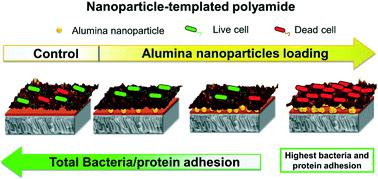当前位置:
X-MOL 学术
›
Environ. Sci.: Nano
›
论文详情
Our official English website, www.x-mol.net, welcomes your
feedback! (Note: you will need to create a separate account there.)
Nanoparticle-templated polyamide membranes for improved biofouling resistance
Environmental Science: Nano ( IF 5.8 ) Pub Date : 2021-1-28 , DOI: 10.1039/d0en01101k Naiara Mottim Justino 1, 2, 3, 4, 5 , Denice Schulz Vicentini 1, 2, 3, 4 , Kiarash Ranjbari 5, 6, 7, 8, 9 , Marion Bellier 5, 6, 7, 8, 9 , Diego José Nogueira 1, 2, 3, 4 , William Gerson Matias 1, 2, 3, 4 , François Perreault 5, 6, 7, 8, 9
Environmental Science: Nano ( IF 5.8 ) Pub Date : 2021-1-28 , DOI: 10.1039/d0en01101k Naiara Mottim Justino 1, 2, 3, 4, 5 , Denice Schulz Vicentini 1, 2, 3, 4 , Kiarash Ranjbari 5, 6, 7, 8, 9 , Marion Bellier 5, 6, 7, 8, 9 , Diego José Nogueira 1, 2, 3, 4 , William Gerson Matias 1, 2, 3, 4 , François Perreault 5, 6, 7, 8, 9
Affiliation

|
Applying an interlayer of nanomaterial to the support layer during interfacial polymerization results in a change in the polyamide (PA) properties that can be leveraged to improve the performance of desalination membranes. While studies have shown that permeability and selectivity can be increased using an interlayer of nanomaterials, the potential of using this approach to improve the PA properties relevant for fouling and biofouling is less understood. In this study, we investigated how using an interlayer of alumina nanoparticles (Al-NP) to template the interfacial polymerization process affects the fouling and biofouling propensity of thin film composite membranes. Performance was measured by static bacteria and protein deposition assays as well as dynamic reverse osmosis biofouling experiments. The low and medium Al-NP loadings were found to reduce bacteria and protein adhesion while, at a high Al-NP loading, both bacteria and protein adhesion increased. A similar trend was observed in dynamic fouling conditions, with the low and medium Al-NP loadings experiencing less flux decline and lower biofilm volume on the membrane compared to the control or high Al-NP loaded membrane. The superior antifouling properties of these membranes were correlated with the change in the free energy of cohesion of the PA layer formed on the Al-NP interlayer. Our results demonstrate that using an interlayer of Al-NP can alter the PA surface chemistry in a way that reduces membrane fouling; however, there is a threshold loading of Al-NP beyond which fouling propensity increases due to the effect of Al-NP agglomeration on the PA morphology. These results provide useful insights into how NP can be added to the interlayer during interfacial polymerization to improve the performance of desalination membranes.
中文翻译:

纳米粒子为模板的聚酰胺膜,可提高抗生物污垢性
在界面聚合过程中将纳米材料的中间层施加到支撑层上会导致聚酰胺(PA)性能发生变化,可以利用该变化来改善脱盐膜的性能。尽管研究表明,使用纳米材料夹层可以提高渗透性和选择性,但使用这种方法来改善与结垢和生物结垢相关的PA性能的潜力却鲜为人知。在这项研究中,我们研究了如何使用氧化铝纳米颗粒中间层(Al-NP)来模板化界面聚合过程,从而影响薄膜复合膜的结垢和生物结垢倾向。通过静态细菌和蛋白质沉积测定以及动态反渗透生物污染实验测量性能。发现低和中等的Al-NP含量可以减少细菌和蛋白质的粘附,而在高的Al-NP含量下,细菌和蛋白质的粘附都可以增加。在动态结垢条件下观察到类似的趋势,与对照或高Al-NP膜相比,低和中等Al-NP膜的通量下降较小,膜上的生物膜体积较小。这些膜的优异防污性能与在Al-NP中间层上形成的PA层的内聚力的自由能变化相关。我们的结果表明,使用Al-NP中间层可以减少膜结垢的方式改变PA表面的化学性质。但是,存在Al-NP的阈值载荷,由于Al-NP团聚对PA形态的影响,结垢倾向增加。
更新日期:2021-02-02
中文翻译:

纳米粒子为模板的聚酰胺膜,可提高抗生物污垢性
在界面聚合过程中将纳米材料的中间层施加到支撑层上会导致聚酰胺(PA)性能发生变化,可以利用该变化来改善脱盐膜的性能。尽管研究表明,使用纳米材料夹层可以提高渗透性和选择性,但使用这种方法来改善与结垢和生物结垢相关的PA性能的潜力却鲜为人知。在这项研究中,我们研究了如何使用氧化铝纳米颗粒中间层(Al-NP)来模板化界面聚合过程,从而影响薄膜复合膜的结垢和生物结垢倾向。通过静态细菌和蛋白质沉积测定以及动态反渗透生物污染实验测量性能。发现低和中等的Al-NP含量可以减少细菌和蛋白质的粘附,而在高的Al-NP含量下,细菌和蛋白质的粘附都可以增加。在动态结垢条件下观察到类似的趋势,与对照或高Al-NP膜相比,低和中等Al-NP膜的通量下降较小,膜上的生物膜体积较小。这些膜的优异防污性能与在Al-NP中间层上形成的PA层的内聚力的自由能变化相关。我们的结果表明,使用Al-NP中间层可以减少膜结垢的方式改变PA表面的化学性质。但是,存在Al-NP的阈值载荷,由于Al-NP团聚对PA形态的影响,结垢倾向增加。










































 京公网安备 11010802027423号
京公网安备 11010802027423号